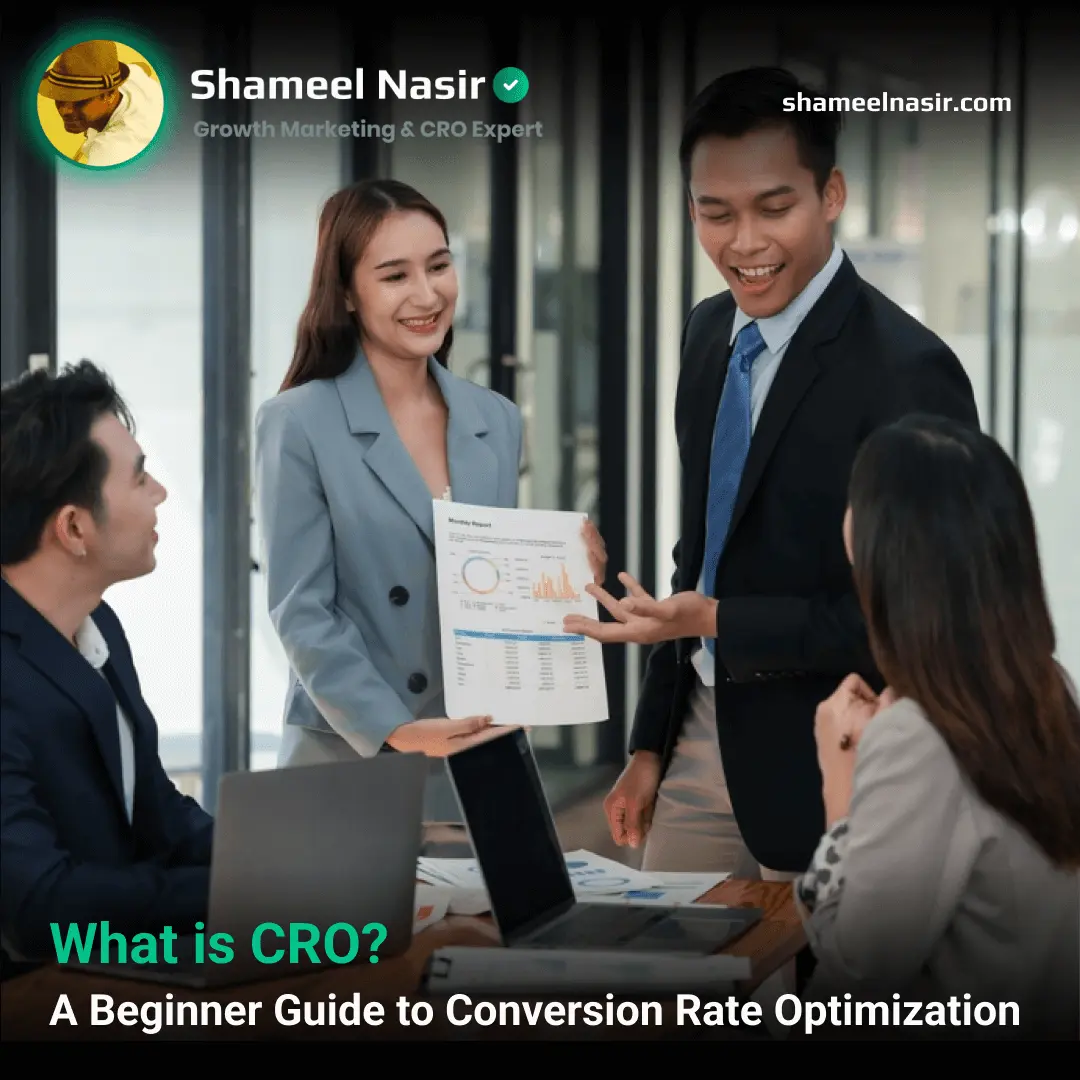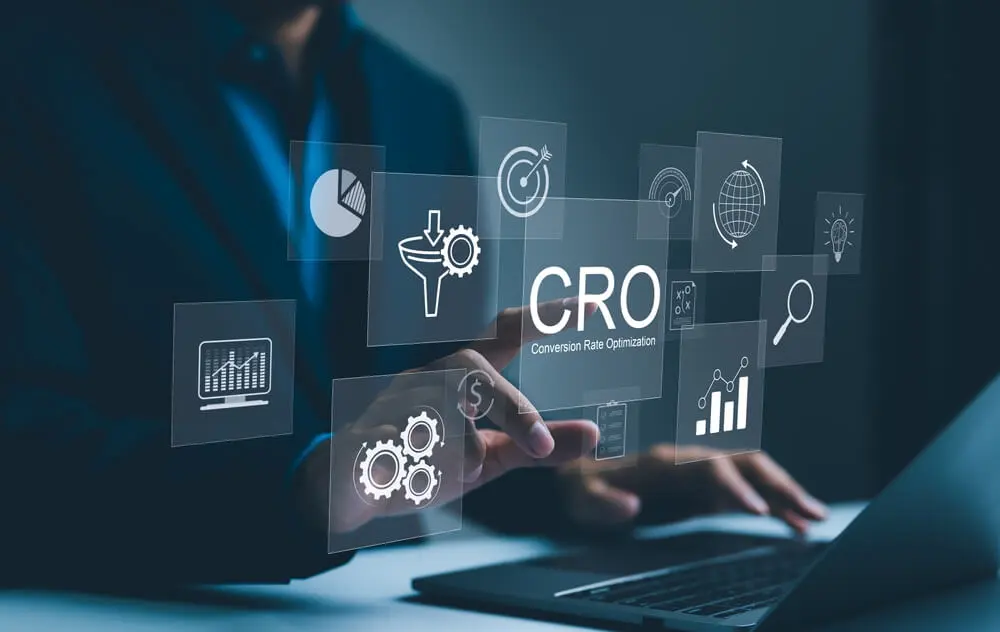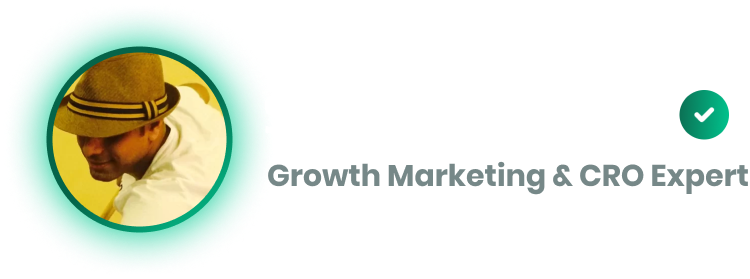
- By CROSHAMEEL
- October 23, 2024
- No Comments
We have curated this guide for you to know what is CRO (Conversion Rate Optimization), how businesses work, and why, what makes conversion rates so significant in the current market. CRO is focused on improving your conversion rates — or getting more of the people who already visit your website or app to become customers.
If you’re new to CRO or need a refresher, don’t worry! Here, we are sharing a beginner’s guide that covers most of what you need to know about conversion rate optimization in any industry form, etc., step by step. However, following these suggestions can boost your sales and scale up the rest of your business.
We will also provide some of the best, most suitable tools and resources for you to track your data more easily. These are just a few of hundreds of insights that will help you understand data and take action to make your business decisions right, well, and prosper.
To see how well your store is performing, contact our experts for an in-depth review of your performance and get valuable input on improving conversion rates.
Check out our what is CRO case studies. We have helped hundreds of e-commerce sites improve conversion rates and grow revenue.
What is a Conversion Rate Optimization?
A strategy to increase the number of people who take a specific action on your website. Such as buying, signing up, etc. It’s to increase the ratio of their visitors who become customers. Need assistance at this point? Our conversion rate optimization service in Dubai makes your site more reliable for transforming guests into clients.
To start with what is CRO, you must determine your website’s current conversion rate. Next, you’ll want to compare your new ideas with what’s already there. To do this, marketers often use different types of testing, such as multivariate, split, and A/B testing—we’ll explain more about these later.
But first, let’s take a step. How do you choose which type of conversion to focus on improving, and how can you tell when your content is genuinely optimized?
What Influences Your Conversion Rate?
Conversion Rate Optimization (what is CRO) might sound technical, but it comes down to a few key elements impacting how many visitors become customers. Here’s what matters:
User Experience: How easy and enjoyable is your site to use?
Website Design: Does your site look good and function well?
Site Speed: How fast does your site load?
Content Quality: Is your content straightforward and valuable?
Pricing and Discounts: Are your deals appealing?
Call-to-Action: Are your prompts to act compelling?
Target Audience: Are you reaching the right people?
Navigation: Can users easily find what they need on your site?
Payment Options: Do you offer convenient ways to pay?
Trustworthiness: Do visitors feel safe on your site?
Each factor is crucial. For instance, if your website is easy to navigate, visitors might need help finding what they’re looking for, which can lead to fewer sales. Likewise, if the content doesn’t meet visitors’ standards, they might need to trust your site more to make a purchase.
Here’s a simple breakdown:
- Poor Navigation: This leads to a high bounce rate.
- Low-Quality Content: Results in a lower conversion rate.
Conversely, a fantastic user experience paired with a compelling call-to-action can make customers more likely to buy, boosting your conversion rates and overall return on investment (ROI).
Why Should You Focus on Conversion Rate Optimization?

Optimization must be done to ensure success and profits. Here’s how it works:
How many hours have you wasted trying to land new clients? That may have been via SEO, paid ads, or organic traffic. All of these methods are intended to attract new leads to your website.
Consider how much you invest in social media marketing and other strategies.
How does your budget break down? You can cut some of these costs by increasing your conversion rate.
Below are a few essential benefits of conversion rate optimization:
Lower Costs:
Most business owners focus on new customers. Their approach to acquiring visitors is simple: They go after new markets, launch ads, and do anything else that can help them increase site traffic. But even more important than that is getting your existing visitors to convert.
After a customer lands on your site, you can make another sale. Each aspect of your e-commerce store plays a role in whether or not they purchase. This allows you to reduce ad spend and improve pathways for your converts through optimization.
Better User Experience:
Hence, optimization is not only limited to increasing customer numbers but also helps provide a fantastic experience. When refined to be user-friendly, every piece of the website is a plus for their experience. This ease of product and service discovery often results in increased conversions.
Higher ROI:
When applied correctly, conversion rate optimization will maximize the return on investment and increase every number you make from your existing traffic. It makes getting the most from your existing customers a continuous practice while attracting new ones at less than half the price. That means you get more without paying for additional ad dollars in a bid auction style.
Stronger Brand Recognition:
Your Brand = The way customers perceive your business. The website is what customers will interact with most often, and it needs to be designed for conversions. If you can provide a better customer experience, they are more likely to recommend your site and return for purchases – thus increasing brand recall & retention.
Sharper Analytics:
After all, analytics is all about the data. The better you make more informed decisions from your data, the more significant your advantage… Conversion rate optimization helps you capitalize on your data and gut instincts to make informed decisions. It allows you to monitor how customers are acting, know what works, and adapt where necessary.
The above points clearly show the importance of effective conversion rate optimization. It helps you get the most out of your current traffic by guaranteeing a good experience for every visitor on the site.
In the following section, we will cover top-level CRO statistics. Explanation of why data matters for CRO
It helps you as data is critical to any growing business. Since data constantly changes, businesses must be on top of the latest trends and what works best. You can improve your conversion rates by knowing the research and applying it to your copy.
If you want one-on-one advice on implementing these tactics or hiring a Shopify CRO expert, contact us today and level up your e-commerce game!
Starting Points for Conversion Rate Optimization (what is CRO)
Here are three essential parts of your website where you can begin using CRO to improve user experience and increase conversions:
1. Product Images
When customers can’t touch or see your products in person, the pictures you use become crucial for making sales. It’s important to use high-quality, clear photos that highlight each item’s best features.
If possible, add a 360-degree view, a demo video, or a 3D model to give a complete visual impression. This helps customers feel more confident about what they’re buying as if they had seen it in a store. Plus, showing your products from multiple angles can answer questions about size and fit, reducing doubts and potentially cutting down on returns.
Product Details
Just like the images you use, the descriptions of your products are vital ways shoppers connect with what you’re selling. While it might be tempting to go on at length about each item in your store, the most effective product descriptions are detailed and to the point.
If your descriptions include more information about how the product is made, how it fits, or what makes it unique, customers may not feel confident enough to buy it. On the other hand, too much detail can overwhelm shoppers and cause them to ignore the descriptions.
Aim to write clear, short descriptions that emphasize your products’ key features and benefits. Use bullet points and include pictures to break up text and make it easier to read. This approach helps customers quickly get the information they need and encourages them to purchase.
2. Blog Content
Your blog posts, especially those optimized for search engines that draw in readers, are a great place to increase conversions. Concentrate on strengthening the calls to action and generating leads within each post. Keep your messaging clear and direct to guide readers on what to do next, whether signing up for a newsletter, downloading a resource, or checking out a product.
Call to Action
A call to action (CTA) guides your audience through the next steps. Often, a CTA appears as a button or link that moves the audience further along your sales funnel.
Effective CTAs in blog posts are relevant to the article’s topic and might encourage readers to explore a product or category without demanding an immediate purchase. A/B testing can reveal the best places to insert CTAs in your posts and determine which phrases will most likely draw clicks. For more tailored advice, consider a call to Shopify CRO Expert, who can refine your strategy.
Lead Generation
Use your blog posts to offer readers additional content like downloadable PDFs, checklists, or a collection of curated articles. Techniques like these are excellent for turning readers into sales leads by capturing their email addresses and keeping their interest. This approach enriches their experience and builds your database of potential contacts.
3. Effective Landing Page
Landing pages are crafted to transform visitors into leads or customers. Often, the first thing a new visitor encounters on your site, the design and content of your landing page, are critical. You want to nail that first impression by methodically testing and refining how information is organized and presented.
This approach helps ensure that visitors are greeted with a clear, engaging layout that guides them smoothly toward making a decision, boosting your chances of converting them.
Understanding Information Hierarchy
Arrange the content on your landing page according to its importance to your readers. Place the most essential details at the top of the page, such as your main offer and the call to action. Valuable but less critical information, like customer testimonials or extra details about your products, can go lower down on the page.
This setup helps visitors quickly see the essential messages first, improving their experience and your chances of making a conversion.
10 CRO Key Points to Increase Your Store Conversions
- Implement Secure Shopify Checkout
- Streamline Clear Calls to Action
- Conduct Comprehensive A/B Testing
- Introduce Interactive Pop-Ups
- Install a Welcoming Hello Bar
- Display Convincing Social Proof
- Enhance Intelligent Search Bars
- Apply Insightful Heat Maps
- Send Targeted Abandoned Cart Emails
- Optimize for Fast Speed and Mobile Responsiveness
